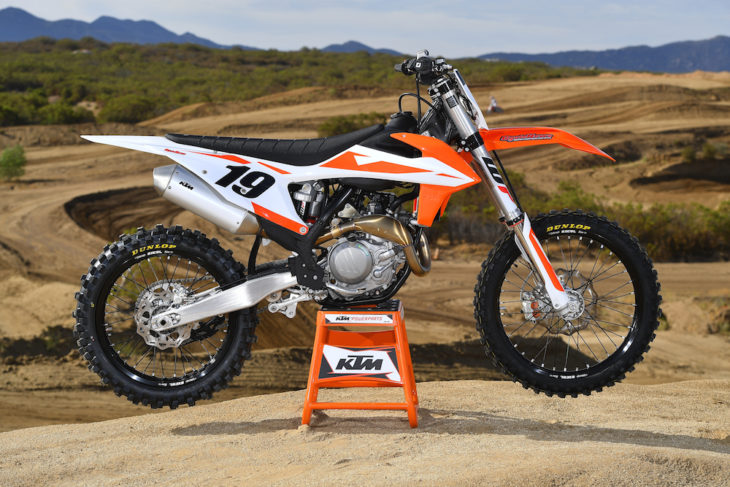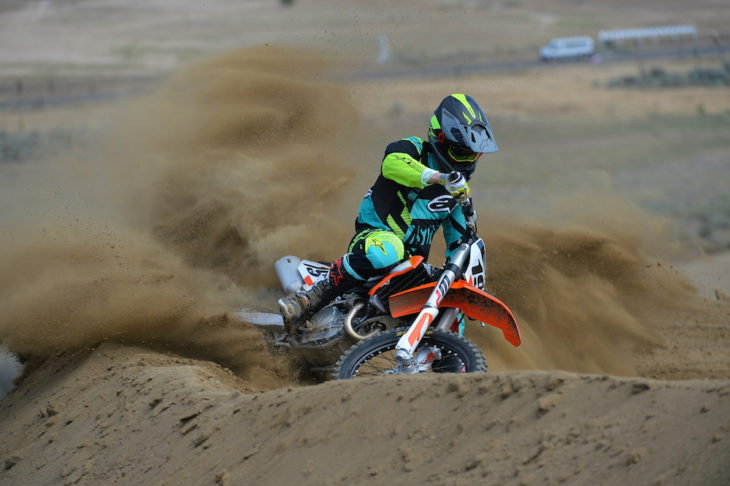| September 21, 2018
Through the late 1900s, the Japanese manufacturers had a lock on the motocross market because they had, far and away, the best bikes. It was as simple as that. A few European brands tried to loosen the Big Four’s stranglehold on the market, but they did not have a ton of success. KTM, however, did build quality bikes at the time but were perceived as an off-road specific brand, at least in the U.S., and were still catching up in MX.
2019 KTM 450 SX-F First Riding Impression
 The lightest bike in its class, the 2019 KTM 450 SX-F feels ultra light and agile. Photos: Mark Kariya
The lightest bike in its class, the 2019 KTM 450 SX-F feels ultra light and agile. Photos: Mark Kariya
That pretty much all changed recently when KTM decided it didn’t want to play second fiddle to the Japanese bikes anymore, and when KTM sets out to do something, they usually succeed. And they did here, too.
Their road trip to the top started in 2011 when the Austrians lured Roger DeCoster away from Suzuki and hired the former five-time 500cc MX World Champion as their new MX race team manager, who insisted on hiring new supercross and motocross champion Ryan Dungey, as well. For that to happen, they had to lure Dungey over with the promise of building him a competitive motorcycle. Both sides eventually agreed and the rest is, as the say, history.
Today, KTM produces—and has for a number of years now—one of the top 450cc production motocross bikes in the business, keeping the Japanese engineers up late at night trying to think of ways to stay ahead, or at least keep pace, with the Austrians. KTM’s latest entry into the 450cc four-stroke market is the 2019 450 SX-F, an offshoot of its latest Factory Edition model, which made its debut late December (2018) as a limited edition model. You might say that it’s not limited anymore, now that it is the standard 450cc motocross bike in KTM’s latest lineup.
 At nearly $10,000, the 2019 KTM 450 SX-F isn’t cheap but you’ll quickly forget about that as soon as you get it home.
At nearly $10,000, the 2019 KTM 450 SX-F isn’t cheap but you’ll quickly forget about that as soon as you get it home.
Compared to the standard 2018 450 SX-F, the 2019 has received a lot of changes, including a new frame that has been designed with more longitudinal stiffness for increased control over bumps. The swingarm now has a 5mm longer slot for added wheelbase adjustment and stability. The bike has new bodywork with updated ergonomics and better contact points for the rider, and the radiators are mounted lower to help with the center of gravity. The seat is also newly shaped and silicone strips were for added for better grip.
The engine features many changes, as well. It has a lighter and more compact cylinder head that sits 15mm lower than before. It also features DLC-coated intake rockers and a low friction cam chain guide for added durability and performance. The new transmission is made by Pankl (a sister company of KTM’s); it has the same ratio as the previous model but is made of upgraded materials for improved reliability. The 2019 also has new maps for the ECU, a new header and muffler, and a lighter lithium battery to power the electric starter.
Get On It!
I was super anxious to ride the 2019 KTM 450 SX-F for the first time, and when I did, the first thing I noticed was how light the bike felt when lifting it off the stand. I had to do a double take to make sure I wasn’t mistakenly grabbing a 125 and not the 450; seriously, it feels that light.
 The KTM turns extremely well.
The KTM turns extremely well.
As I set my lever and bar positions, I also noticed how narrow and streamlined the bike felt. The seat was flat and grippy and the rider triangle (footpeg/seat/handlebar relationship) felt comfortable right away. Within the first lap I was truly impressed by how easily it was to get used to. In years past, I always felt like I needed a lot of time to get acquainted with the KTM, more so than I did with other brand bikes, but that wasn’t the case with the KTM. After a few laps, I was already comfortable on it, and I started to pick up the pace. The bike felt stable on the fast parts of the track but also felt nimble enough to slice across the track and dive into an inside rut with ease. For a 450, I was immediately impressed with its agility.
I haven’t been a fan of air forks these days, but I have no problem giving credit when credit is due. The KTM’s WP AER air forks are actually quite good and would have to say the best forks KTM has ever put on one of its production MX bikes. But first you have to get them dialed in, and the WP’s are quite simple to tune for an air fork. With the WP AERs, one leg handles air pressure and the other damping. KTM recommends 157 pounds as a good starting point and from there, you can tinker with the clickers until you find the best combination of air pressure (preload) and damping, compression and rebound, for your weight, riding style and preference. Once you’re there, the WP AER’s perform quite well. I don’t think they’re the best forks in the business, but they’re pretty darn good and would think they’d be easy enough to live with for quite some time.
Shock action was equally good, if not a little better, and the bike felt very balanced, front to back, right from the get go.
 Oh, yes, there is plenty of power and it’s all useable.
Oh, yes, there is plenty of power and it’s all useable.
Handling has been a KTM strong suit for quite a while now, and nothing has changed. It has excellent stability and rarely does anything weird, and the light-feeling KTM corners extremely well. It pretty much goes where it’s pointed without argument and tends to stay where it’s been told once it settles in. It comes fitted with well-liked Dunlop MX3 tires.
The engine is impressive, as well. KTM offers two different (shift-on-the-fly) map switches with the addition of traction control on the left side of the handlebars. The difference between position one (stock) and position two (aggressive) is more noticeable than it was last year. Since the track I rode was mainly sandy with lots of hills, I preferred the aggressive setting.
Overall, the engine is very smooth and progressive yet very powerful, no matter what map you’re using.
Traction control, which also came on the previous model, is unique to the KTM (and near-twin brother Husqvarna). On this day, on this track, however, I didn’t feel traction control was much of advantage but would be, for sure, on a more hard-packed track. In general, though, I think it’s a pretty cool deal.
The KTM uses a hydraulically operated clutch, which it has for many years, that provides a light pull and great feel. Some of that also has to do with its unique internal diaphragm-spring design. KTM clutches rarely fade and have a reputation for being rugged and durable, and I doubt these things are going to change with this bike.
Brakes are strong and have excellent feel, but what else is new when it comes to KTM’ Brembo brakes? They are often called the best in the business, and I can see why.
The KTM feels extremely slim between your legs, so it’s very easy to move around on, and the seat cover has mega grip.
 2019 KTM 450 SX-F
2019 KTM 450 SX-F
At the end of the day, I was extremely impressed with the KTM. I almost can’t get over how light it is and how much power it makes while still being easy to use and manipulate. I love the clutch, the brakes, and the way the bike feels between my legs. It is also a solid-handling motorcycle, and its suspension is very good, but not outstanding—I would love to ride this bike with a good set of spring forks. A better EFI tuning system would be nice, too. Yamaha’s new smartphone app system has really spoiled me.
Still, the KTM is an amazing piece of moto machinery and one I would certainly consider keeping in my garage.
By RICKY YORKS
Click here for more KTM motorcycle reviews.
Click here for more Cycle News Motocross bike reviews and news.